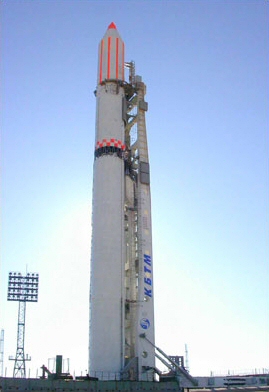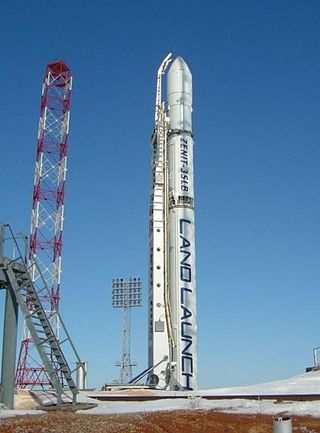
Zenit is a family of space launch vehicles designed by the Yuzhnoye Design Bureau in Dnipro, Ukraine, which was then part of the Soviet Union. Zenit was originally built in the 1980s for two purposes: as a liquid rocket booster for the Energia rocket and, equipped with a second stage, as a stand-alone middle-weight launcher with a payload greater than the 7 tonnes of the Soyuz but smaller than the 20 tonnes payload of the Proton. The last rocket family developed in the USSR, the Zenit was intended as an eventual replacement for the dated Soyuz and Proton families, and it would employ propellants which were safer and less toxic than the Proton's nitrogen tetroxide/UDMH mix. Zenit was planned to take over crewed spaceship launches from Soyuz, but these plans were abandoned after the dissolution of the Soviet Union in 1991.

The Dnepr rocket was a space launch vehicle named after the Dnieper River. It was a converted ICBM used for launching artificial satellites into orbit, operated by launch service provider ISC Kosmotras. The first launch, on April 21, 1999, successfully placed UoSAT-12, a 350 kg demonstration mini-satellite, into a 650 km circular Low Earth orbit.
The Zenit-2M, Zenit-2SB, Zenit-2SLB or Zenit-2FG was a Ukrainian expendable carrier rocket derived from the Zenit-3SL. It was a member of the Zenit family of rockets, which were designed by the Yuzhmash.

This article outlines notable events occurring in 2005 in spaceflight, including major launches and EVAs. 2005 saw Iran launch its first satellite.

Land Launch refers to a service product of Sea Launch SA. There is no entity or company called Land Launch. Sea Launch created the Land Launch offering to address lighter satellites directly into geosynchronous orbit or into geosynchronous transfer orbit, while Sea Launch continues to address the heavy satellite launch market.
Fregat (Russian: Фрегат, frigate) is an upper stage developed by NPO Lavochkin in the 1990s, which is used in some Soyuz and Zenit launch vehicles, but is universal and can be used as a part of a medium and heavy class launch vehicles. Fregat became operational in February 2000. Its liquid propellant engine uses UDMH and N2O4. Fregat's success rate is 97.8% (with 2 failures in 93 launches), which makes it one of the most reliable upper stages in the world. Fregat has successfully delivered more than 300 payloads into different orbits. It remains the only upper stage in the world that can place its payload into 3 or more different orbits in a single launch.

Soyuz-2 is a modernized version of the Soviet Soyuz rocket. In its basic form, it is a three-stage launch vehicle for placing payloads into low Earth orbit. Compared to the previous versions of the Soyuz, the first-stage boosters and two core stages feature uprated engines with improved injection systems. Digital flight control and telemetry systems allow the rocket to be launched from a fixed launch platform, whereas the launch platforms for earlier Soyuz rockets had to be rotated as the rocket could not perform a roll to change its heading in flight.

The year 2011 saw a number of significant events in spaceflight, including the retirement of NASA's Space Shuttle after its final flight in July 2011, and the launch of China's first space station module, Tiangong-1, in September. A total of 84 orbital launches were conducted over the course of the year, of which 78 were successful. Russia, China and the United States conducted the majority of the year's orbital launches, with 35, 19 and 18 launches respectively; 2011 marked the first year that China conducted more successful launches than the United States. Seven crewed missions were launched into orbit during 2011, carrying a total of 28 astronauts to the International Space Station. Additionally, the Zenit-3F and Long March 2F/G carrier rockets made their maiden flights in 2011, while the Delta II Heavy made its last.

The Zenit 3SLB or Zenit-3M is a Ukrainian expendable carrier rocket derived from the Zenit-2SB. It is a member of the Zenit family of rockets, which were designed by the Yuzhnoye Design Office. Produced at Yuzhmash, the rocket is a modified version of the Zenit-3SL, designed to be launched from a conventional launch pad rather than the Sea Launch Ocean Odyssey platform. Most of components of the rocket are produced in Russia.
The Zenit-3F, Zenit-3SLBF or Zenit-2SB/Fregat is an expendable carrier rocket. It is a member of the Zenit family of rockets, which were designed by Yuzhnoye Design Bureau of Ukraine.

Elektro–L is a series of meteorological satellites developed for the Russian Federal Space Agency by NPO Lavochkin. The first satellite, Elektro-L No.1, was launched on 2 January 2011. It is the first Russian weather satellite that successfully operates in geostationary orbit, and is currently the second operational Russian weather satellite. The satellites have a mass of about 1620 kg and are designed to operate for 10 years each. They are capable of producing images of the Earth's whole hemisphere in both visible and infrared frequencies, providing data for climate change and ocean monitoring in addition to their primary weather forecasting role.

Elektro-L No.1, also known as Geostationary Operational Meteorological Satellite No.2 or GOMS No.2, is a Russian geostationary weather satellite which was launched in 2011. The first Elektro-L spacecraft to fly, it became the first Russian geostationary weather satellite to be launched since Elektro No.1 in 1994.
The Blok DM-03, GRAU index 11S861-03, is a Russian upper stage used as an optional fourth stage on the Proton-M heavy-lift rocket. Three have been launched, the first in December 2010; the first two launches failed before fourth stage ignition, the first as a result of a problem with the Blok DM's fuel load.
Kosmos 12 or Zenit-2 No.6 was a Soviet optical film-return reconnaissance satellite launched in 1962. A Zenit-2 spacecraft, Kosmos 12 was the seventh of eighty-one such satellites to be launched.
Kosmos 46 or Zenit-2 No.23 was a Soviet, first generation, low resolution, optical film-return reconnaissance satellite launched in 1964. A Zenit-2 spacecraft, Kosmos 46 was the twenty-second of eighty one such satellites to be launched and had a mass of 4,730 kilograms (10,430 lb).
Kosmos 99 or Zenit-2 No.32 was a Soviet, first generation, low resolution, optical film-return reconnaissance satellite launched in 1965. A Zenit-2 spacecraft, Kosmos 99 was the thirty-second of eighty-one such satellites to be launched and had a mass of 4,730 kilograms (10,430 lb).
Kosmos 120 or Zenit-2 No.41 was a Soviet, first generation, low resolution, optical film-return reconnaissance satellite launched in 1966. A Zenit-2 spacecraft, Kosmos 120 was the thirty-ninth of eighty-one such satellites to be launched and had a mass of 4,730 kilograms (10,430 lb).
Kosmos 143 or Zenit-2 No.45 was a Soviet, first generation, low resolution, optical film-return reconnaissance satellite launched in 1967. A Zenit-2 spacecraft, Kosmos 143 was the forty-sixth of eighty-one such satellites to be launched and had a mass of 1,730 kilograms (3,810 lb).
AngoSat 1 was a geostationary communications satellite operated by Angosat and built by the Russian company RKK Energia. It was the first communications satellite of Angola, designed for a 15-year mission to deliver television, internet, and radio services to Angola and other territories. The satellite suffered a power problem in the first hours of flight and lost contact with ground control. After the power problem, contact was established with the satellite, but ultimately the satellite did not recover, and contact was lost permanently 3 days into the mission. After repeated failures to establish contact in the following weeks/months, the satellite was declared lost. Russia built a replacement satellite AngoSat 2.







